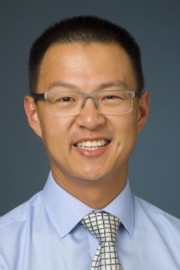Scientist profiles G-L
SRI profiles

Associate scientist
Sunnybrook Health Sciences Centre
2075 Bayview Ave., Room M1 102
Toronto, ON
M4N 3M5
Administrative Assistant: Yvonne Locker
Clinical ProfileShow/hide details
Education:
- Queen's University, Faculty of Medicine, 2000
Surgical Training:
- Otolaryngology - Head & Neck Surgery, University of Toronto, 2000-2005
Fellowship Training:
- Neurotology & Skull Base Surgery, University of Toronto (Drs. Nedzelski & Chen), 2005-2006
- Research Fellowship in Auditory and Vestibular Hair Cell Regeneration, Virginia Merrill Bloedel Hearing Research Centre, University of Washington (Drs. Rubel & Stone), 2006-2008
Academic Highlights:
- American Otological Society Research Fellow, 2006-2008
- Solvay Pharma Fellowship Award, 2005-2006
Research ProfileShow/hide details
Administrative Assistant: Yvonne Locker
Phone: 416-480-6100 ext. 67251
Email: yvonne.locker@sunnybrook.ca
Education:
- MD, 2000, Queen's University, Canada
- Fellow of the Royal College of Surgeons of Canada (FRCSC), 2005, otolaryngology/head and neck surgery, University of Toronto, Canada
- Clinical fellow, 2006, otology/neurotology, University of Toronto, Canada
- American Otologic Society research fellow, 2008, Virginia Merrill Bloedel Hearing Research Centre, University of Washington School of Medicine, U.S.
Appointments and Affiliations:
- Associate scientist, Biological Sciences, Hurvitz Brain Sciences Research Program, Sunnybrook Research Institute
- Assistant professor, department of otolaryngology, head and neck surgery, University of Toronto
- Otologist/neurotologist, Sunnybrook Health Sciences Centre
Research Foci:
- Auditory hair cell regeneration
- Cochlear implantation
- Skull base tumours
- Middle ear and mastoid disease
- Hearing and balance
Research Summary:
The vast majority of hearing loss is caused by a loss of auditory hair cells, which are contained in the cochlea or the organ of hearing. Hair cells help convert sound (acoustic) energy into neural (electrical) signals, which then travel via the auditory nerve to the brain where sound is interpreted. It was recently discovered that some types of birds, after going deaf, were able to regenerate hair cells spontaneously and fully restore hearing function. This discovery led many scientists and otologists (ear surgeons) to conclude that understanding this process and triggering the same response in humans will ultimately lead to a cure for hearing loss.
The department of otolaryngology, head and neck surgery at Sunnybrook Health Sciences Centre is home to Canada's only research laboratory in hearing regeneration. The overall goal of Dr. Lin's research is to develop therapeutic interventions that will regenerate and restore normal hearing to those affected with hearing loss. The three specific aims of his laboratory include the following:
- to further the understanding of the cell pathways that trigger and control hair cell regeneration in the avian species
- to identify the "stem cells" in adult hearing impaired birds and mice as models of human hearing loss (the goal is to manipulate these stem cells in mammalian models to repopulate the lost hair cells)
- to develop effective techniques for sustained drug delivery directly and selectively to the human inner ear using the mouse as a model organism.
Selected Publications:
See current publications list at PubMed.
- Chung J, Chueng K, Shipp D, Friesen L, Chen JM, Nedzelski JM, Lin VY. Unilateral multi-channel cochlear implantation results in significant improvement in quality of life. Otol Neurotol. 2012 Jun;33(4):566–571.
- Monteiro E, Shipp D, Chen J, Nedzelski J, Lin V. Cochlear implantation: a personal and societal economic perspective examining the effects of cochlear implantation on personal income. J Otolaryngol Head Neck Surg. 2012 Apr;41 Suppl 1:S43–48.
- Kandasamy T, Clinkard DJ, Qian W, Chen S, Chen JM, Harrison RV, Lin VY. Changes in expression of vascular endothelial growth factor and its receptors in the aging mouse cochlea, part 1: the normal-hearing mouse. J Otolaryngol Head Neck Surg. 2012 Apr;41 Suppl 1:S36–42.
- Clinkard DJ, Amoodi H, Lin VY, Chen JM, Nedzelski JM. Improved hearing with cochlear implantation in Fabry's disease. Cochlear Implants Int. 2011 Nov;12(4):238–240.
- Hugh SC, Shipp DB, Chen JM, Nedzelski JM, Lin VY. When do we choose the 'better balance' ear for cochlear implants? Cochlear Implants Int. 2011 Nov;12(4):190–193.
Related News and Stories:
- The fundamentals: eyes and ears: Often overlooked as part of the brain, these portals of perception are essential to living to our full potential (SRI Magazine, 2013)
Related Links:


